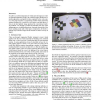Free Online Productivity Tools
i2Speak
i2Symbol
i2OCR
iTex2Img
iWeb2Print
iWeb2Shot
i2Type
iPdf2Split
iPdf2Merge
i2Bopomofo
i2Arabic
i2Style
i2Image
i2PDF
iLatex2Rtf
Sci2ools
ISMAR
2008
IEEE
2008
IEEE
Compositing for small cameras
To achieve a realistic integration of virtual and real imagery in video see-through augmented reality, the rendered images should have a similar appearance and quality to those captured by the video camera. This paper describes a compositing method which models the artefacts produced by a small low-cost camera, and adds these effects to an ideal pinhole image produced by conventional rendering methods. We attempt to model and simulate each step of the imaging process, including distortions, chromatic aberrations, blur, bayer masking, noise and colour-space compression, all while requiring only an RGBA image and an estimate of camera velocity as inputs.
Augmented Reality | Ideal Pinhole Image | ISMAR 2008 | See-through Augmented Reality | Small Low-cost Camera |
| Added | 31 May 2010 |
| Updated | 31 May 2010 |
| Type | Conference |
| Year | 2008 |
| Where | ISMAR |
| Authors | Georg Klein, David W. Murray |
Comments (0)

